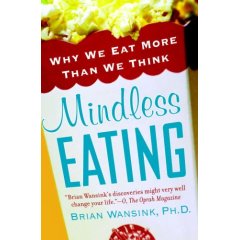
"Everyone--every single one of us--eats how much we eat largely because of what's around us. We overeat not because of hunger but because of family and friends, packages and plates, names and numbers, labels and lights, colors and candles, shapes and smells, distractions and distances, cupboards and containers. This list is almost as endless as it's invisible.
Invisible?
Most of us are blissfully unaware of what influences how much we eat . . . We all think we're too smart to be tricked by packages, lighting, or plates. We might acknowledge that others could be tricked, but not us. That is what makes mindless eating so dangerous. We are almost never aware that it is happening to us."
So opens Brian Wansink's book, Mindless Eating: Why we eat more than we think .
Wansink studies consumer behavior at Cornell University. He's the guy who scrutinizes in excruciating detail why we eat what we do, what factors determine what we eat like food color and smell, the company we keep, product packaging. He works without food industry funding, though there are plenty of researchers who do this sort of research funded by the likes of Kraft, Nabisco, and Kellogg's.
His book is packed full of the conclusions he and his team have come to over the years studying our buying and eating habits. While this information could (and is) be easily used by the food industry to coerce us to eat more and more, understanding many of the concepts Wansink talks about can also open your eyes to their clever tactics.
He especially details how our internal satiety signals fail us when external cues are present that easily trip us up. He talks about one experiment he ran in which soup bowls were rigged with concealed rubber tubes in the bottom that continually replenished the soup as the person consumed it. Thus, with the bowl continually refilled, the eater had no idea how much he or she had consumed. When the quantity of soup eaten from the endless bowl was compared to people eating from standard bowls, there was as much as a three-fold increase in the quantity and calories eaten.
Just be aware that, while Wansink is an expert in consumer eating behavior, he is not necessarily an expert in nutrition. Just as a card shark can show you lots of clever tricks to hoodwink your opponent, he might not be the best person to teach you how to play bridge.
For a great hint at some of the interesting and all-too-human observations Wansink makes, the online Prevention Magazine posted a brief video:
http://link.brightcove.com/services/link/bcpid1155399889/bclid1171884988/bctid1113465050
We might not be able to stop Big Food from selling garbage foods, but we can at least be armed with insight into how we are subconsciously coerced into eating more.